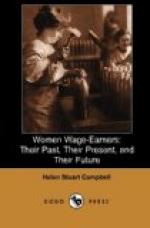Looking at the time as a whole, one sees clearly how old distinctions had become obliterated. Wealth found new definitions. The Church had made poverty the highest state, and insisted, as she does in part to-day, that the suffering and deprivation of one class were ordained of God to draw out the sympathies of the other. The rich must save their souls by alms and endowments, and contentment and acquiescence were to be the virtues of the poor.
Insensibly this view was modified. Charlemagne, whose extraordinary personal power and common-sense moulded men at will, set an example no monarch had ever set before. He ordered the sale of eggs from his hens and the vegetables from his gardens; and, scorn it as they might, his sneering nobles insensibly modified their own thought and action. Commerce brought the people and products of new countries face to face. The lines of caste, as sharply defined within the labor world as without, were gradually dimmed or obliterated. The practice of credit and exchange, largely the creation of the persecuted Jews, made easy the interchange of commodities. Saint Louis himself organized industry, and divided the trades into brotherhoods, put under the protection of the saints from the tyranny of the barons and of the feudal system which had weighted all industry.
Reform began in the year 1257, in the “Institutions” of Saint Louis,—a set of clear and definite rules for the development of public wealth and the general good of the people. In their first joy at this escape from long-continued oppression, many of the towns of the Middle Ages had admitted women to citizenship on an equal footing with men. In 1160 Louis le Jeune, of France, granted to Theci, wife of Yves, and to her heirs, the grand-mastership of the five trades of cobblers, belt-makers, sweaters, leather-dressers, and purse-makers. In Frankfort and the Silesian towns there were female furriers; along the middle Rhine many female bakers were at work. Cologne and Strasburg had female saddlers and embroiderers of coats-of-arms. Frankfort had female tailors, Nuremburg female tanners, and in Cologne were several skilled female goldsmiths.
Twelve hundred years of struggle toward some sort of justice seemed likely at this point to be lost, for with the opening of the thirteenth century each and all of the guilds proceeded to expel every woman in the trades. It is a curious fact in the story of all societies approaching dissolution, that its defenders adopt the very means best adapted to hasten this end. Each corporation dreaded an increase of numbers, and restricted marriages, and reduced the number of independent citizens. Many towns placed themselves voluntarily under the rule of princes who in turn were trying to subjugate the nobility, and so protected the towns and accorded all sorts of rights and privileges.
The Thirty Years’ War, from 1618 to 1648, decimated the German population, and reduced still further the possibility of marriage for many. Forced out of trades, women had only the lowest, most menial forms of trade labor as resort, and their position was to all appearance nearly hopeless.




